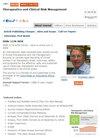Efficacy and Safety of Hydrogen Therapy in Patients with Early-Stage Interstitial Lung Disease: A Single-Center, Randomized, Parallel-Group Controlled Trial
IF 2.8
3区 医学
Q1 Pharmacology, Toxicology and Pharmaceutics
引用次数: 0
Abstract
Purpose: Several in vivo experiments have shown that molecular hydrogen is a promising therapeutic agent for interstitial lung diseases (ILD). In this study, hydrogen therapy was investigated to determine whether it is superior to N-Acetylcysteine (NAC) for the treatment of patients with early-stage ILD.Patients and Methods: A prospective, single-center, randomized, controlled clinical trial was conducted in 87 patients with early-stage ILD. Hydrogen or NAC therapy was randomly assigned (1:1 ratio) to the eligible patients. The primary endpoint was the change in the high-resolution computed tomography (HRCT) and composite physiologic index (CPI) scores from baseline to week 48. Pulmonary function was evaluated as a secondary endpoint, and adverse events were recorded for safety analysis.
Results: The rate of HRCT image improvement from the baseline in the HW group (63.6%) was higher than that in the NAC group (39.5%). A significant decrease in CPI and improvement in DLCO-sb were observed in the hydrogen group compared with those in the control group. Changes in other pulmonary function parameters, including FVC, FEV1, FEV1/FVC%, and TLC, were not significantly different between the two groups. Adverse events were reported in 7 (15.9%) patients in the HW group and 10 (23.3%) patients in the NAC group, but the difference was not significant (P=0.706).
Conclusion: Hydrogen therapy exhibits superior efficacy and acceptable safety compared with NAC therapy in patients with early-stage ILD.
Keywords: hydrogen, N-acetylcysteine, interstitial lung disease, therapeutic effects
氢气疗法对早期间质性肺病患者的疗效和安全性:单中心、随机、平行组对照试验
目的:多项体内实验表明,分子氢是一种治疗间质性肺病(ILD)的有效药物。本研究对氢气疗法进行了调查,以确定它在治疗早期 ILD 患者方面是否优于 N-乙酰半胱氨酸(NAC):对 87 名早期 ILD 患者进行了前瞻性、单中心、随机对照临床试验。符合条件的患者被随机分配接受氢气或 NAC 治疗(比例为 1:1)。主要终点是高分辨率计算机断层扫描(HRCT)和综合生理指数(CPI)评分从基线到第 48 周的变化。肺功能作为次要终点进行评估,并记录不良事件进行安全性分析:HW组的HRCT图像比基线改善率(63.6%)高于NAC组(39.5%)。与对照组相比,氢气组 CPI 明显下降,DLCO-sb 明显改善。其他肺功能参数(包括 FVC、FEV1、FEV1/FVC% 和 TLC)的变化在两组之间无明显差异。氢气治疗组有 7 例(15.9%)患者出现不良反应,NAC 组有 10 例(23.3%)患者出现不良反应,但差异不明显(P=0.706):关键词:氢气;N-乙酰半胱氨酸;间质性肺病;疗效
本文章由计算机程序翻译,如有差异,请以英文原文为准。
求助全文
约1分钟内获得全文
求助全文
来源期刊

Therapeutics and Clinical Risk Management
HEALTH CARE SCIENCES & SERVICES-
CiteScore
5.30
自引率
3.60%
发文量
139
审稿时长
16 weeks
期刊介绍:
Therapeutics and Clinical Risk Management is an international, peer-reviewed journal of clinical therapeutics and risk management, focusing on concise rapid reporting of clinical studies in all therapeutic areas, outcomes, safety, and programs for the effective, safe, and sustained use of medicines, therapeutic and surgical interventions in all clinical areas.
The journal welcomes submissions covering original research, clinical and epidemiological studies, reviews, guidelines, expert opinion and commentary. The journal will consider case reports but only if they make a valuable and original contribution to the literature.
As of 18th March 2019, Therapeutics and Clinical Risk Management will no longer consider meta-analyses for publication.
The journal does not accept study protocols, animal-based or cell line-based studies.
 求助内容:
求助内容: 应助结果提醒方式:
应助结果提醒方式:


